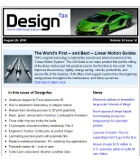 |
| July 21, 2020 | Volume 16 Issue 27 |
Electrical/Electronic News & Products
Designfax weekly eMagazine
Archives
Partners
Manufacturing Center
Product Spotlight
Modern Applications News
Metalworking Ideas For
Today's Job Shops
Tooling and Production
Strategies for large
metalworking plants
Board-level EMI shielding: DIY in minutes
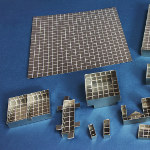 ProtoShield sheets from Tech-Etch are depth-etched with a checkerboard pattern for folding, so they can be easily formed into many diverse configurations. In the product-development stage, fully functional shields can be created in minutes with just a pair of scissors and a straight edge for folding. Offered in two sizes: standard (.25-in. squares) and metric (5-mm squares). Both versions are solderable and corrosion resistant due to nickel silver material. Shield prototypes can be directly soldered to the board, or shield clips can be used for easy mounting. Samples available.
ProtoShield sheets from Tech-Etch are depth-etched with a checkerboard pattern for folding, so they can be easily formed into many diverse configurations. In the product-development stage, fully functional shields can be created in minutes with just a pair of scissors and a straight edge for folding. Offered in two sizes: standard (.25-in. squares) and metric (5-mm squares). Both versions are solderable and corrosion resistant due to nickel silver material. Shield prototypes can be directly soldered to the board, or shield clips can be used for easy mounting. Samples available.
Learn more.
Isolated probing tech for fast-switching power device testing
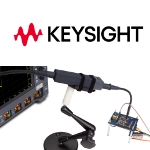 Keysight Technologies has developed an optically isolated differential probing family dedicated to enhancing efficiency and performance testing of fast-switching devices such as wide-bandgap GaN and SiC semiconductors. Validation of floating half-bridge and full-bridge architectures commonly used in power conversion, motor drives, and inverters requires measurement of small differential signals riding on high common-mode voltages. This measurement can be challenging due to voltage source fluctuations relative to ground, noise interference, and safety concerns.
Keysight Technologies has developed an optically isolated differential probing family dedicated to enhancing efficiency and performance testing of fast-switching devices such as wide-bandgap GaN and SiC semiconductors. Validation of floating half-bridge and full-bridge architectures commonly used in power conversion, motor drives, and inverters requires measurement of small differential signals riding on high common-mode voltages. This measurement can be challenging due to voltage source fluctuations relative to ground, noise interference, and safety concerns.
Learn more.
Protect sensitive electronics in explosive environments with new aluminum ATEX Cabinet Cooler Systems
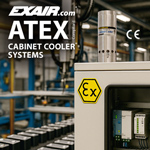 EXAIR's ATEX Cabinet Cooler® Systems deliver a powerful and affordable solution for keeping electrical enclosures cool in hazardous ATEX classified areas -- and they're now available in durable aluminum construction. Engineered for use in Zones 2 and 22, these coolers are UL tested, CE compliant, and meet stringent ATEX standards for purged and pressurized enclosures. With cooling capacities up to 5,600 Btu/Hr., ATEX Cabinet Coolers are ideal for preventing overheating in electrical cabinets. EXAIR offers a comprehensive lineup of systems.
EXAIR's ATEX Cabinet Cooler® Systems deliver a powerful and affordable solution for keeping electrical enclosures cool in hazardous ATEX classified areas -- and they're now available in durable aluminum construction. Engineered for use in Zones 2 and 22, these coolers are UL tested, CE compliant, and meet stringent ATEX standards for purged and pressurized enclosures. With cooling capacities up to 5,600 Btu/Hr., ATEX Cabinet Coolers are ideal for preventing overheating in electrical cabinets. EXAIR offers a comprehensive lineup of systems.
Learn more.
PLC handbook chock full of must-know information
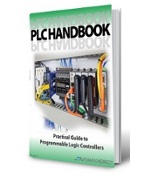 Automation-Direct's Practical Guide to Program-mable Logic Controllers Handbook has been improved with tons of new need-to-know info, making it a more comprehensive guide to the world of PLCs. Besides covering the basics of PLC history, PLC hardware, and PLC software, this guide takes you deeper into the ever-changing world of PLC communication, the importance of feedback loops, cyber security, and many other areas that are a must-know for any PLC novice or seasoned automation professional.
Automation-Direct's Practical Guide to Program-mable Logic Controllers Handbook has been improved with tons of new need-to-know info, making it a more comprehensive guide to the world of PLCs. Besides covering the basics of PLC history, PLC hardware, and PLC software, this guide takes you deeper into the ever-changing world of PLC communication, the importance of feedback loops, cyber security, and many other areas that are a must-know for any PLC novice or seasoned automation professional.
Get this great resource today.
Haptic feedback prototyping kit from TDK
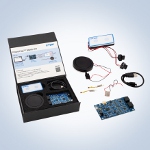 Get your customers to feel the difference your products make. TDK has released a development starter kit for fast haptics prototyping. It gives mechanical designers and engineers first impressions of the haptic feedback using PowerHap piezo actuators, shows how the mechanical integration works, and provides a reference design. Applications include automotive, displays and tablets, household appliances, vending machines, game controllers, industrial equipment, and medical devices.
Get your customers to feel the difference your products make. TDK has released a development starter kit for fast haptics prototyping. It gives mechanical designers and engineers first impressions of the haptic feedback using PowerHap piezo actuators, shows how the mechanical integration works, and provides a reference design. Applications include automotive, displays and tablets, household appliances, vending machines, game controllers, industrial equipment, and medical devices.
Learn more.
Mini ESD preset torque screwdriver
 Need precision fastening with ESD protection at the smallest torque levels? Mountz has you covered. The new FG Mini ESD Preset Torque Screwdriver is built for low-torque, high-precision tasks. Its compact design makes it ideal for tight spaces and small fasteners, while delivering the same reliable control and ESD protection users have come to expect from Mountz. Two models available: FG25z (3 to 25 ozf.in, 2 to 17.7 cN-m) and FG50z (20 to 50 ozf.in, 14.1 to 35.3 cN-m).
Need precision fastening with ESD protection at the smallest torque levels? Mountz has you covered. The new FG Mini ESD Preset Torque Screwdriver is built for low-torque, high-precision tasks. Its compact design makes it ideal for tight spaces and small fasteners, while delivering the same reliable control and ESD protection users have come to expect from Mountz. Two models available: FG25z (3 to 25 ozf.in, 2 to 17.7 cN-m) and FG50z (20 to 50 ozf.in, 14.1 to 35.3 cN-m).
Learn more.
Laumas load cells and electronics from AutomationDirect
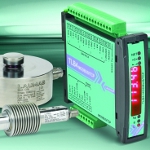 Automation-Direct has added Laumas precision-engineered load cells, transmitters, and accessories that deliver reliable performance in industrial weighing and force measurement applications. The FCAL series high-precision bending beam load cells are ideal for low- to mid-capacity systems. CTL series load cells are designed for both tension and compression, with excellent linearity. The CBL series low-profile compression load cells are perfect for space-limited applications. Laumas load cell transmitters are available too for precise monitoring and control. Very good pricing.
Automation-Direct has added Laumas precision-engineered load cells, transmitters, and accessories that deliver reliable performance in industrial weighing and force measurement applications. The FCAL series high-precision bending beam load cells are ideal for low- to mid-capacity systems. CTL series load cells are designed for both tension and compression, with excellent linearity. The CBL series low-profile compression load cells are perfect for space-limited applications. Laumas load cell transmitters are available too for precise monitoring and control. Very good pricing.
Learn more.
Engineer's Toolbox: What is ground loop feedback?
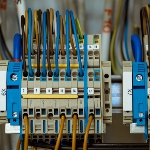 Improper grounding can create problems in data logging, data acquisition, and measurement and control systems. One of the most common problems is known as ground loop feedback. Experts at CAS DataLoggers run through five ways to eliminate this problem.
Improper grounding can create problems in data logging, data acquisition, and measurement and control systems. One of the most common problems is known as ground loop feedback. Experts at CAS DataLoggers run through five ways to eliminate this problem.
Read the full article.
What is a braking resistor?
 According to Automation-Direct, "Braking resistors don't actually provide braking directly -- rather, they allow a drive to stop a loaded motor faster." Why is this important? Protect your AC or DC drive system from regenerative voltage that can create an over-voltage fault on the drive -- especially with high inertial loads or rapid deceleration.
According to Automation-Direct, "Braking resistors don't actually provide braking directly -- rather, they allow a drive to stop a loaded motor faster." Why is this important? Protect your AC or DC drive system from regenerative voltage that can create an over-voltage fault on the drive -- especially with high inertial loads or rapid deceleration.
View the video.
New Digital Static Meter: Precise measurement, easy use
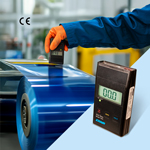 Static electricity isn't just a nuisance; it's a serious threat to manufacturing efficiency, product integrity, and workplace safety. Unchecked static can lead to costly downtime, product defects, material jams, and even hazardous shocks to employees. If static is interfering with your processes, EXAIR's upgraded Model 7905 Digital Static Meter offers an essential first step in identifying and eliminating the problem. With just the press of a button, this easy-to-use, handheld device pinpoints the highest voltage areas in your facility, helping you diagnose static issues before they become a problem.
Static electricity isn't just a nuisance; it's a serious threat to manufacturing efficiency, product integrity, and workplace safety. Unchecked static can lead to costly downtime, product defects, material jams, and even hazardous shocks to employees. If static is interfering with your processes, EXAIR's upgraded Model 7905 Digital Static Meter offers an essential first step in identifying and eliminating the problem. With just the press of a button, this easy-to-use, handheld device pinpoints the highest voltage areas in your facility, helping you diagnose static issues before they become a problem.
Learn more.
New laser cutting modulating strategy tested with Mikrotron high-speed camera
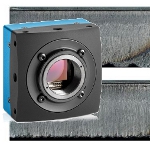 Modulating a laser beam's intensity distribution optimizes energy delivery to the process zone, resulting in better cutting speed, cut edge quality, and cut kerf geometry. Scientists in Belgium have come up with a new method that they say produces better cutting results.
Modulating a laser beam's intensity distribution optimizes energy delivery to the process zone, resulting in better cutting speed, cut edge quality, and cut kerf geometry. Scientists in Belgium have come up with a new method that they say produces better cutting results.
Read the full article.
All-in-one embedded PLC based on Raspberry Pi 4 -- build control applications
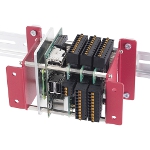 The new PLC CPI-PS10CM4 from Contec Co. is a compact embedded programmable logic controller (PLC) that is loaded with CODESYS, the world's most widely used software PLC. This product uses Contec's original single-board computer, which is based on Raspberry Pi's latest embedded module, the Compute Module 4 (CM4). By using the wide range of peripheral devices for Raspberry Pi, such as Contec's CPI Series, you can build various control applications in a PLC language that complies with the IEC 61131-3 international standard.
The new PLC CPI-PS10CM4 from Contec Co. is a compact embedded programmable logic controller (PLC) that is loaded with CODESYS, the world's most widely used software PLC. This product uses Contec's original single-board computer, which is based on Raspberry Pi's latest embedded module, the Compute Module 4 (CM4). By using the wide range of peripheral devices for Raspberry Pi, such as Contec's CPI Series, you can build various control applications in a PLC language that complies with the IEC 61131-3 international standard.
Learn more.
Torque sensors for fastening applications and more
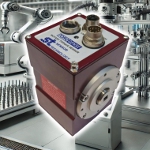 Saelig Company has introduced the Sensor Technology SGR525/526 Series Torque Sensors to provide precision torque monitoring that is critical for performance and safety. The square drive design (for applications with non-cylindrical shafts) allows for seamless integration into power tools, test rigs, industrial machinery, and precision fastening applications, ensuring superior torque measurement without the need for additional adapters or modifications. The SGR525 offers torque measurement only, while the SGR526 provides torque, speed, and power measurement using a 360-pulse-per-revolution encoder. Industries include automotive, aerospace, manufacturing, and research and development.
Saelig Company has introduced the Sensor Technology SGR525/526 Series Torque Sensors to provide precision torque monitoring that is critical for performance and safety. The square drive design (for applications with non-cylindrical shafts) allows for seamless integration into power tools, test rigs, industrial machinery, and precision fastening applications, ensuring superior torque measurement without the need for additional adapters or modifications. The SGR525 offers torque measurement only, while the SGR526 provides torque, speed, and power measurement using a 360-pulse-per-revolution encoder. Industries include automotive, aerospace, manufacturing, and research and development.
Learn more.
Wide-angle camera optimized for larger, faster conveyor belts
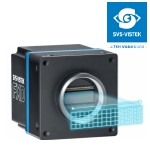 Wider conveyor belts operating at higher speeds are now commonplace in modern logistics. To keep up, SVS-Vistek is offering a cost-effective alternative to multi-camera systems with its fxo901CXGE 10-GigE color camera featuring the Sony IMX901-AQR wide-aspect global shutter 16.4-megapixel CMOS sensor. Unlike standard cameras, this unit captures targets in a wide field of view while maintaining high resolutions. The 4:1 horizontal aspect ratio allows one fxo901CXGE to replace an entire multi-camera system, removing the need for image synchronization.
Wider conveyor belts operating at higher speeds are now commonplace in modern logistics. To keep up, SVS-Vistek is offering a cost-effective alternative to multi-camera systems with its fxo901CXGE 10-GigE color camera featuring the Sony IMX901-AQR wide-aspect global shutter 16.4-megapixel CMOS sensor. Unlike standard cameras, this unit captures targets in a wide field of view while maintaining high resolutions. The 4:1 horizontal aspect ratio allows one fxo901CXGE to replace an entire multi-camera system, removing the need for image synchronization.
Learn more.
Handheld thermal imager cuts diagnostic time
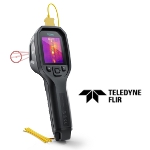 The FLIR TG268 is a next-generation thermal imager that provides professionals in the utility, manufacturing, electrical, automotive, and industrial sectors with a lightweight, handheld, affordable condition monitoring tool. Latest enhancements include higher temperature ranges, improved resolution, and larger data storage capacity. Go beyond the restrictions of single-spot IR thermometers to view and evaluate hot and cold spots that may signify potentially dangerous issues. Accurately measure temps from -25 to 400 C. Native thermal images improved with Super Resolution upscaling.
The FLIR TG268 is a next-generation thermal imager that provides professionals in the utility, manufacturing, electrical, automotive, and industrial sectors with a lightweight, handheld, affordable condition monitoring tool. Latest enhancements include higher temperature ranges, improved resolution, and larger data storage capacity. Go beyond the restrictions of single-spot IR thermometers to view and evaluate hot and cold spots that may signify potentially dangerous issues. Accurately measure temps from -25 to 400 C. Native thermal images improved with Super Resolution upscaling.
Learn more.
New fast-charging, long-running, bendable supercapacitor may be energy storage breakthrough
A new discovery overcomes one of the most pressing issues faced by high-powered, fast-charging supercapacitors: They usually cannot hold a large amount of energy in a small space. The work was published by researchers at University College London Feb. 17 in Nature Energy. While at the proof-of-concept stage, it shows enormous potential as a portable power supply in several practical applications including electric vehicles, phones, and wearable technology.
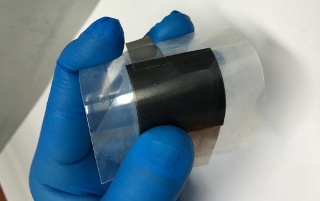
A new bendable supercapacitor made from graphene can be charged quickly, and it safely stores a record-high level of energy for use over a long period. [Credit: Dr Zhuangnan Li (UCL)]
First author of the study, Dr Zhuangnan Li (UCL Chemistry), said, "Our new supercapacitor is extremely promising for next-generation energy storage technology as either a replacement for current battery technology, or for use alongside it, to provide the user with more power.
"We designed materials which would give our supercapacitor a high power density (that is how fast it can charge or discharge) and a high energy density (which will determine how long it can run for)," he said. "Normally, you can only have one of these characteristics, but our supercapacitor provides both, which is a critical breakthrough.
"Moreover, the supercapacitor can bend to 180 degrees without affecting performance and doesn't use a liquid electrolyte, which minimizes any risk of explosion and makes it perfect for integrating into bendy phones or wearable electronics."
A team of chemists, engineers, and physicists worked on the new design, which uses an innovative graphene electrode material with pores that can be changed in size to store the charge more efficiently. This tuning maximizes the energy density of the supercapacitor to a record 88.1 Wh/L (Watt-hour per liter), which is the highest ever reported energy density for carbon-based supercapacitors.
Similar fast-charging commercial technology has a relatively poor energy density of 5 to 8 Wh/L, and traditional slow-charging but long-running lead-acid batteries used in electric vehicles typically have 50-90 Wh/L.
While the supercapacitor developed by the team has a comparable energy density to state-of-the-art lead-acid batteries, its power density is two orders of magnitude higher at over 10,000 Watt per liter.
Senior author and Dean of UCL Mathematical & Physical Sciences, Professor Ivan Parkin (UCL Chemistry), said, "Successfully storing a huge amount of energy safely in a compact system is a significant step towards improved energy storage technology. We have shown it charges quickly, we can control its output, and it has excellent durability and flexibility, making it ideal for development for use in miniaturized electronics and electric vehicles. Imagine needing only 10 minutes to fully charge your electric car or a couple of minutes for your phone -- and it lasting all day."
The researchers made electrodes from multiple layers of graphene, creating a dense but porous material capable of trapping charged ions of different sizes. They characterized it using a range of techniques and found it performed best when the pore sizes matched the diameter of the ions in the electrolyte.
The optimized material, which forms a thin film, was used to build a proof-of-concept device with both a high power and high energy density.
The 6-cm x 6-cm supercapacitor was made from two identical electrodes layered on either side of a gel-like substance that acted as a chemical medium for the transfer of electrical charge. This was used to power dozens of light-emitting diodes (LEDs) and was found to be highly robust, flexible, and stable.
Even when bent at 180 degrees, it performed almost the same as when it was flat, and after 5,000 cycles, it retained 97.8 percent of its capacity.
Senior author, Professor Feng Li (Chinese Academy of Sciences), said: "Over the next 30 years, the world of intelligent technology will accelerate, which will greatly change communication, transportation, and our daily lives. By making energy storage smarter, devices will become invisible to us by working automatically and interactively with appliances. Our smart cells are a great example of how the user experience might be improved, and they show enormous potential as portable power supply in future applications."
Source: University College London
Published March 2020
Rate this article
View our terms of use and privacy policy
